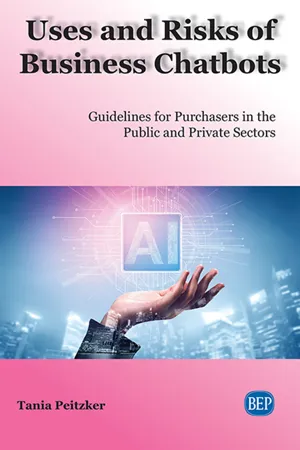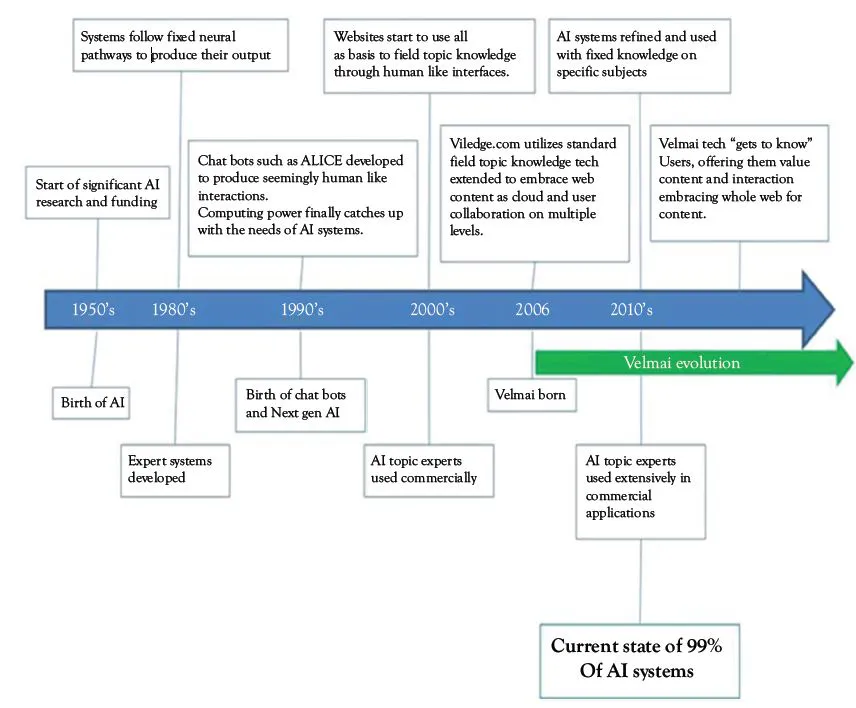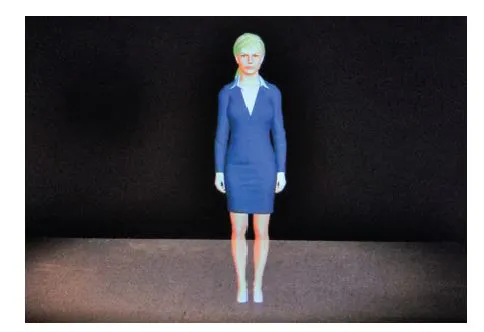![]()
CHAPTER 1
A Brief Historical Overview of Botification
The world first saw the concept of interactive bots emerge in the 1950s with Professor Alan Turing’s attempts to recreate his lost boyfriend in a machine. Then came the prototypical chatbots Alice and Eliza as the first intelligent agents operating as machine–human interaction.
These botified, female 2D avatars were the beginning of the post-1960s application of the now famous Turing Test. Derived from Professor Turing’s musings on the emergent field, it says we as a species will have achieved Artificial Intelligence (AI) when laypeople talk with a computer. If after five minutes of conversing via the machine interface they are not sure if it is a human or not they are chatting with, then the Turing Test for reaching AI will have been reached.
Figure 1.1 Timeline of “chatbot evolution” from the 20th to the 21st centuries, developed for conference talks, pitches, and business plans. © Cliff Lee, CCO from velmai Ltd
The prerequisite for this test—best known as the annual chatbot championships symbolized by the Loebner Prize originally from New York—is that the human participants do not know from the outset which of their conversational partners via a cognitive interface is the actual machine, or what has come to be known as a chatbot.
The English computer scientist from the 18th century Ada Lovelace is now acknowledged as the founding “mother of AI.” The previous chart begins with its most popular “founding father” of definitions of AI bots, chatbots, virtual assistants, and cognitive interfaces or human–machine interaction, the computer scientist, engineer, and code breaker Alan Turing from the United Kingdom. The chart was used as a sales pitch document by velmai Ltd, a 2D chatbot early stage venture that I co-owned for many years in Britain.
We have progressed from 2D bot development to botification of cognitive interfaces. Portia the Conference Bot hologram gave a keynote speech on her own when she was livestreamed from our Porto Lab via our Devon Lab—within seconds—to Lausanne for the Applied Machine Learning Days in January 2019. We have a busy 12 months ahead for Portia and other bespoke AI bot holograms who have been requested to be autonomous keynote speakers at AI conferences and trade shows around the world.
I contemplated writing this guidebook and checklist compilation without my industry’s jargon. However, for the purposes of this text that would in fact be counterproductive. This book is meant to be educational and a helpful tool in the upskilling of corporate managers and government decision makers for the ever more difficult software-as-a-service (SaaS) purchasing decision they must make. Therefore the best remedy against confusion, panic, and dismay that I may be speaking an incomprehensible mish-mash of labels, terms, and hipster speak designating emerging tech and trends is the glossary at the end of this book.
Figure 1.2 “Portia the conference AI bot” hologram was livestreamed to the prestigious Swiss annual conference, the Applied Machine Learning Days (AMLD) in Lausanne in January 2019. Here you see the bot brain in its second iteration, as Amalia the Wayfinder with Portia as an alter ego who is activated with a spoken “wake word.” © AI BaaS UG, Munich, 2019
Please use it. Frequently. It is the best way to learn new stuff, especially terminology, definitions, and concepts, if you keep flicking back to the glossary to check your understanding and memory of various combined definitions that “crossover” or converge into in the fascinating world of what is now known universally as “AI.” Robots and Terminators aside, there is a lot of content that is quite straightforward and a “no brainer” once you read a short simple definition for a baffling term or concept. Use this book equally as a dictionary and a guide, a hands-on list of things to watch out for and selling points to check in any sales pitch or contract negotiation.
Practice certainly does make perfect. However, I truly understand the impulsive urge to press the panic button when this often hyped up field of science—and increasingly widespread “sales- inspired, misselling” fiction—becomes overwhelming and inconsistent. Unfortunately for some of the best innovators and entrepreneurs in our individual societies, wherever we may live or have emigrated to, the knee jerk reaction of purchasers has been paralysis.
Given the ongoing and sometimes astonishing media hype and outright misleading product/service descriptions by unethical companies, we should be wary of the public information about bots and their evolution. Very few academics are teaching the subject of chatbot or IVA history, even less about unethical technology marketing, as part of the curriculum, even though the number of bot conferences and chatbot-related topics including Mixed Reality installations are growing daily.
An Overview of Terms in the Glossary
Conference programs frequently refer to these probably unheard of topics outside of our tech industry bubble. The following terms mean the more sophisticated chatbots that perform at an advanced level of commercialized, often corporate, deployment:
- Conversational AI
- Conversational interfaces
- Interactive interfaces
- Cognitive interfaces
- Cognitive AI
- NLU bots
- NLP bots
- Chatbots with AI
- Mixed Reality
- Interactive gaming with chatbot avatars
- Virtual Reality using the aforementioned
- Augmented Reality, though interactive it has not yet been botified
- Intelligent Virtual Assistants (IVAs)
- Smart Assistants
- Next-gen bots
- AI bots and AI bots as a service (AI BaaS)
Reasons Obstructing Heavy Industry Applications and Commercialization
My company, trademarked as AI BaaS, is preparing to integrate our algorithm into some interesting heavy industry and commercial applications. The reasons it has not yet been done by us or our competitors until now is because of the following:
- Most hologram software is built in Unity and independent source codes that cannot be integrated with, that is, the API is not compatible.
- On Augmented Reality (AR) apps, again they are either built in an unsuitable API or do not allow for integrations with proprietary algorithms outside of the systems they were developed in.
- The users, that is, corporate clients are not yet aware of the need to have an interactive bot within the Virtual Reality (VR) and/or AR experience.
- The clients or owners of the application using VR and AR do not realize that their app is not truly interactive. It does not use voice or speech recognition (ASR), only touch interaction via screens or buttons on a device.
- They do not yet understand that Natural Language Understanding NLU and AI allows us to inject an avatar into the experience to fully realize conversational commerce/AI.
These are just some of the technical reasons and obstacles to botifying more applications to create better experiences in Mixed Reality use cases. Following is a closer look at the attitudinal or psychological blockages that must be overcome by the prospective clients in order to see more widespread commercial uptake of chatbots, their 3D MR (Mixed Reality) next gen cousins, and AI applications generally.
What’s With the Attitude? Why Disruptive and Emerging Tech Gets Blocked by Human Minds
“If in doubt, don’t” often preached my conservative, ever pragmatic Franconian-German immigrant father (whose Bavarian mother had a German Jewish father) to his children in Australia. A saying paraphrased from the former U.S. president Benjamin Franklin. Probably nobody back then would have been cognizant of the need for a set of clones of inventor, activist, and newspaper owner Benjamin Franklin, America’s earliest thinker and technologist you could say. Franklin, who was the first ever American ambassador to France, shaped what came to be known as the liberal democratic American ethos with his antiauthoritarian values...


